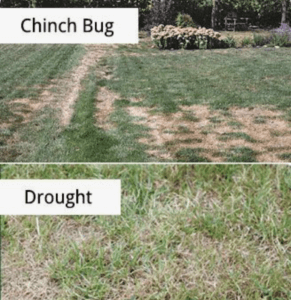Many assume damage and yellowing areas of lawns is due to drought stress, but many times the source of the problem is Chinch bugs.
According to the University of Florida Gardening Solutions, St. Augustinegrass is the most widely planted turfgrass species in Florida lawns, estimated to cover more than 2 million acres.
Which pest loves the St. Augustinegrass? The southern Chinch Bug. This bug is the most damaging insect pest of turfgrass in the state. They are a major pest of St. Augustinegrass, and can rapidly cause a lot of damage.
If you think you might have a Chinch Bug infestation, the first step is to call for an inspection. Call Now: (321) 499-9114 or fill out our contact form. We can quickly begin treating the problem.

Chinch bugs are small, growing to only 1/5 of an inch long as adults. They are black and have white wings that overlap over their bodies. Each wing has a black triangle shape near the body. Their legs are light brown. Chinch bugs of all ages have piercing mouthparts that puncture grass blades, suck out all of the grass’s natural fluids and nutrients, causing it to dehydrate and die. They also feed on plant fluids causing leaf blades to sicken and die.
June through August is noted for the highest infestations of chinch bugs. Dry grass with heavy thatch is often attractive to these insects.
It’s important to remember that not all brown grass indicates a chinch bug infestation. If you suspect you have chinch bugs, inspect the border between the brown and green grass for the tiny, black-and-white adults or orange nymphs. If you do have chinch bugs, you’ll need to devise a plan to get rid of them.
How Does Green Wing Treat a Chinch Bug Problem? Catching a southern chinch bug infestation early is crucial to saving your lawn. Chinch infestations can get out of hand quickly and seriously impact your turf. Without quick treatment, a chinch problem will only cause more harm. Luckily, these pests can be controlled starting with the first visit. We create a follow-up schedule for your home or business to keep these pests at bay. Click here to learn more about our process.
Once the Chinch Bugs are banished from your lawn, you can immediately re-sod the patchy spots. The healthier the lawn, the more beneficial insects it will contain—and therefore the more difficult it for chinch bugs to gain the upper hand. Mow at recommended levels, remove thatch, water consistently, and aerate the lawn can all prevent chinch bugs.
Life is good pest-free.
Your bug guy,
Jeff
